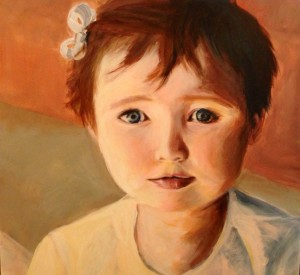
I recently completed this portrait of my friend’s little niece. At some point, whenever I paint a person, the accumulated sketches and brushstrokes suddenly communicate the likeness of that person–as if the real subject glances out at me from the canvas. I usually get this brief glimpse partway into painting and spend the rest of the time trying to complete the vision of that person. Though I add many layers of paint to the canvas during this process, it feels more like peeling back layers of mistaken or incomplete impressions as the painting approaches something that looks more and more like the true subject.
As I worked on this particular painting, the effect of accumulated brushstrokes and impressions made me think about how much painting a person is like getting to know a person.
When we meet someone, hear about them, read about them, we begin to form a picture in our mind of that person. An artist puts these initial impressions down on paper in what’s called a gesture drawing. Gesture drawings provide the foundation for a painting, so they must eventually define distinct shapes and spaces. But they begin as fluid drawings that the artist uses to discover and explore his subject.
To discover and explore his subject, the artist must look at his subject. While that sounds very obvious, it isn’t easy to do in practice. A person new to gesture drawing often looks down at his own paper too often because he fears making mistakes. Paradoxically, this leads to poorer drawings. When you meet a new person, do you ever find yourself distracted by worries about how you yourself appear? Or have you had trouble speaking with someone who seemed preoccupied with his own appearance? I leave both sorts of meetings without any real knowledge of the other person. Whether an encounter happens on the page or in real life, we learn more if we look more at the other person.
Artists make gesture drawings with lighter, less permanent tools–I use a combination of soft pencils and charcoal. The flexibility of these mediums allows for and encourages exploratory lines and corrections. The humble nature of these tools reflects the inherent humility of gesture drawing and can also illustrate the humility with which we should encounter others. All good gesture drawings result from attention to the subject and a willingness on the part of the artist to correct errors when he discovers them.
In drawing and painting, I’ve learned to expect that my early impressions will be incomplete and a little off and sometimes just plain old wrong. This helps me to worry less about making mistakes and focus more on finding the lines that do reflect the true shape of the subject. If I draw with too heavy of a hand early on, I end up spending a lot of time correcting errors. This is like passing final judgments on people before you get to know them. If I approach a drawing or a person in real life with more patience and humility, I end up with more useful lines and accurate impressions that provide better foundations on which to build more truthful drawings and relationships.
Abstract art has its place, but I love drawing from life because the real subject sits there as a constant challenge to my work and to my assumptions. This can be incredibly frustrating; reality is frustrating! Sometimes I look so hard at a difficult spot on the subject that my eyes start to sting because I’ve forgotten to blink. But that’s exactly when you don’t settle for an approximation. You keep looking and looking and, eventually, you will discover something about the subject you hadn’t seen before. The same is true of real life relationships with others as well as our relationship with God.
When I struggle with painting a subject, I think of this passage in A Grief Observed where C.S. Lewis considers how his late wife and God refuse to conform to his assumptions:
My idea of God is not a divine idea. It has to be shattered time after time. He shatters it himself . . . The earthly beloved, even in this life, incessantly triumphs over your mere idea of her. And you want her to; you want her with all her resistances, all her faults, all her unexpectedness. That is, in her foursquare and independent reality.
It’s easy to draw our friends and family and strangers and God into crude little boxes of expectations. But they don’t fit, and we should be glad they don’t fit. Like gesture drawing, getting to know others and getting to know God is something we can always work on. It just requires that we spend time honestly looking at the other and that we don’t stop looking when we find ourselves challenged by what we see.





